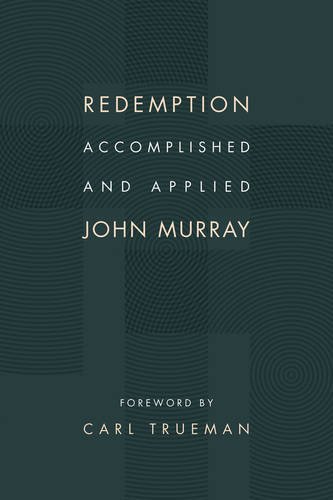A Brief Book Summary from Books At a Glance
About the Author
John Murray was the famed professor of Systematic Theology at Westminster Seminary, 1930-1968.
Table of Contents
Foreword to the 2015 Edition, by Carl Trueman
Preface to the First Edition
Part 1: Redemption Accomplished
Chapter 1: The Necessity of the Atonement
Chapter 2: The Nature of the Atonement
Chapter 3: The Perfection of the Atonement
Chapter 4: The Extent of the Atonement
Conclusion
Part 2: Redemption Applied
Chapter 1: The Order of Application
Chapter 2: Effectual Calling
Chapter 3: Regeneration
Chapter 4: Faith and Repentance
Chapter 5: Justification
Chapter 6: Adoption
Chapter 7: Sanctification
Chapter 8: Perseverance
Chapter 9: Union with Christ
Chapter 10: Glorification
Indexes
Overview
John Murray’s classic work Redemption Accomplished and Applied is divided into two parts of the same name: the accomplishment of redemption on the one hand, and its application on the other. Murray argues that the biblical witness views redemption as a seamless garment. The atonement and its application unto the salvation of God’s people are all of the piece.
The very structure of Murray’s book plainly presents atonement as central to the concept of redemption, in particular, to redemption’s accomplishment. The traditional loci of soteriology and the ordo salutis comprise the second half of the book, redemption’s application. Therefore, one can ascertain the various levels latent in Murray’s concept, as it by some “cascade effect”: redemption is the largest category which colors and flavors the entirety of the Christian gospel. Atonement accomplishes such a redemption through Christ. Salvation set forth such a redemption in sinful humans.
Part 1: Redemption Accomplished
Chapter 1: The Necessity of the Atonement
Murray begins chapter 1 “The Necessity of the Atonement” with atonement’s non-necessity. That is, he begins not by proffering that the atonement is any matter to be deduced first and foremost from a prior premise but instead to be hung upon the declaration of the love of God. The first note to be struck and sound to be heard in redemption is that its ground is in God’s good pleasure and its warrant is simply the gratuitousness of his love. In terms of historical theology, Murray proceeds then to discuss views on the necessity of the atonement: hypothetical necessity and consequent absolute necessity.
Hypothetical necessity argues that “nothing inheres in the nature of God or in the nature of remission of sin that makes blood-shutting indispensable” (6). On this view therefore God could save without an atonement, though he decreed to do so.
Consequent absolute necessity, according to Murray, designates that as a consequence of his decree only, God “was under the necessity of accomplishing this purpose through the sacrifice of his son . . . arising from the perfections of his own nature.” Once God decreed to save, the shedding of blood in the substitutionary sacrifice necessarily follow.
Murray appeals to such passages as Hebrews 2:10, 17 and 9:9–14, 22–28 in support of the consequent absolutely view. He argues that the “transcendent efficacy of Christ’s sacrifice is required by the exigencies deriving from sin” and that “the efficacy of his sacrifice is bound up with the constitution of his person.” Murray further argues from (1) the scripture’s calling Christ’s sacrifice as “true,” from (2) the necessities raised by a center dwelling with a holy God, from (3) the supremacy of the cross as a demonstration of God’s love, and from (4) the necessities involved in the “vindicatory Justice of God” (10-12).
Questions for Discussion and Study
- Is the biblical witness sufficient to sustain Murray’s preferred option? 2a. Moreover, what level of emphasis does the doctrine merit based on the biblical witness 2b. What level of emphasis does it merit based on the integral relationships among the loci of systematic theology?
- What strengths and weaknesses are associated with Murray’s presentation due to the fact that he interacts so briefly with the “hypothetical necessity” view?
- He references Augustine at Aquinas as those who set forth this view, the argumentation of these doctors of the church were relying to a significant degree on philosophical method in the cited chapters. Do you think that Christian philosophy is necessary to extend further discussion on the matter of the atonement’s necessity?
Chapter 2: The Nature of the Atonement
Murray opens his discussion in “The Nature of the Atonement” by offering obedience as a term designating a concept which is “embracive enough to be viewed as the unifying or integrating principle” of the biblical teaching. His primary appeals are to Christ’s suffering, such as in Isaiah 53, John 6:38, John 10:17–19. He confirms his case from the interpretations of the letters: Romans 5:19, Philippians 2:7–8, Hebrews 5:8–9. . . .
[To continue reading this summary, please see below....]The remainder of this article is premium content. Become a member to continue reading.
Already have an account? Sign In
